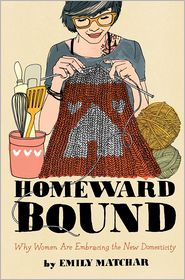I’ve been writing about Homeward Bound a bit sporadically over the past couple of months.
In Chapter 4 of Homeward Bound, Matchar critiques Etsy and “mompreneuership.”
Matchar sets the stage for a feminist critique of Etsy with these statistics: 97% of Etsy sellers are women (p. 73), yet the company was founded by three men (p. 72). The chapter, however, falls a bit short of my hopes of a rich feminist critique. Matchar does raise some very important questions about how Etsy mostly fills the role of low-paid, pink collar work of the past (e.g., direct sales, data entry).
Etsy arose out of “[t]he craft revivial, which began as a rebellious feminist ‘reclaiming’ of old-fashioned domestic arts in the 1990s” (p. 73). I would have liked to learn more about this craft revival at this particular time period. During the 1980s my mom was a crafter and sold hand-painted wood items at craft fairs. She often came home with handmade Cabbage Patch doll clothes from other crafters at these fairs for me and my sister. I suppose my question is when did craft become something to be revived? Was it only when women with the most power (i.e., upper class), began doing it that it become revived? What was my mom doing, then? Was she being perfectly domestic and feminine, but it was later women who were doing something radical? I think these are questions worth exploring.
I know very little about Etsy. I shop on Etsy maybe a couple of times a year. I’ve never sold anything on Etsy or set up an Etsy shop. There are folks, however, within the scrapbooking industry and hobby that are much more invovled with Etsy, which makes me wonder where scrapbooking fits in this overall discussion. I also saw parallels between Etsy and digital designers in digital scrapbooking. Most digital designers make very little money (I’m talking less than $500 a year). Then there are those who repeatedly just give their work away for free. The willingness to work for such little money undercuts those who would like to make a living at it.
The problem with Etsy is one that plagues the digital designing community. For etsians, crafting is a fun hobby, a culture, a community, and possibly a business. Treating what you are doing as a fun hobby compared to a business are two very different things. The hobbyists, make it more difficult for those trying to make it a business. People get used to the low prices that hobbyists set and expect that from those trying to make a living at it. I believe that customers are just as culpable when they make purchases that undermine a worker’s (i.e., crafter’s) livelihood.
Matchar goes on to say,
These days, many have embraced crafting as a hobby or a potential source of income without any particular thought to globalism or factory labor or feminism (p. 77).
This is an important point, yet Matchar provides limited analysis of globalism or factory labor and how it fits in this economic niche. The reality is that I can only conceivably become a mompreneuer making hairbows as long as some other woman in the Global South toils away for little money making low-cost ribbon for the big box craft store. My ability to “have it all” or reclaim a domestic skill as a feminist act depends on the exploitation of some other person (usually a woman) in the Global South. The most recent ribbon I bought came from a big box craft store. It was made in Mexico, which means the person who made it averages $6.48 per day. Moreover, it came from the big box craft store that hides behind religion to restrict women’s reproductive rights. The point is, how can an activity be feminist if it relies on the exploitation of people and denies women’s reproductive rights? (Yes, I realize that I’m culpable, too, by shopping there at all.)
Like blogging, crafting is “enjoyable for many, lucrative for a few, but ultimately fall[s] far short of its promises” (p. 93). If the etsian or crafter embraces the identity of “mompreneuer,” then the ability to scale up and make a serious living at it are all but off limits. To be a mompreneuer means that the “business venture is specifically designed around her lifestyle and child care needs” (p. 86). To scale up would involve making perceived-sacrifices in terms of her child care, family care, and housework expectations. Yet again, what we have is people opting out and accepting low wage work instead of working to improve the system so that it is more conducive to earning an income and family responsibilities. We live in a culture (in the U.S.) that claims to value families, yet regards their existence as a choice. This decreases the likelihood of us working to improve work-life balance within organizations and increases the likelihood of us opting out.
Congratulations, you made it the end! Guess what? I have one copy of Homeward Bound to giveaway to a reader! Just leave a comment below and I’ll pick a winner on Sunday, September 9, 2013.
Read More:





 Stephanie Medley-Rath is a sociologist and scrapbooker who studies scrapbooking and memory keeping. Scrapworthy Lives is a blog focused on her sociological analysis of scrapbooking, with a sprinkling of posts about Stephanie's own scrapbooking projects.
Stephanie Medley-Rath is a sociologist and scrapbooker who studies scrapbooking and memory keeping. Scrapworthy Lives is a blog focused on her sociological analysis of scrapbooking, with a sprinkling of posts about Stephanie's own scrapbooking projects.
